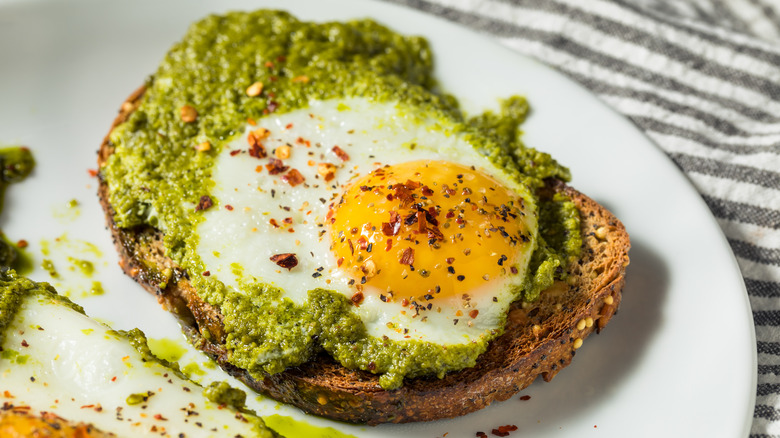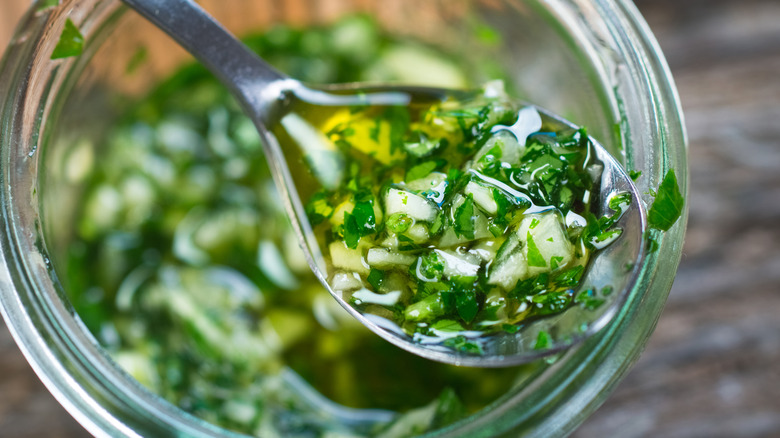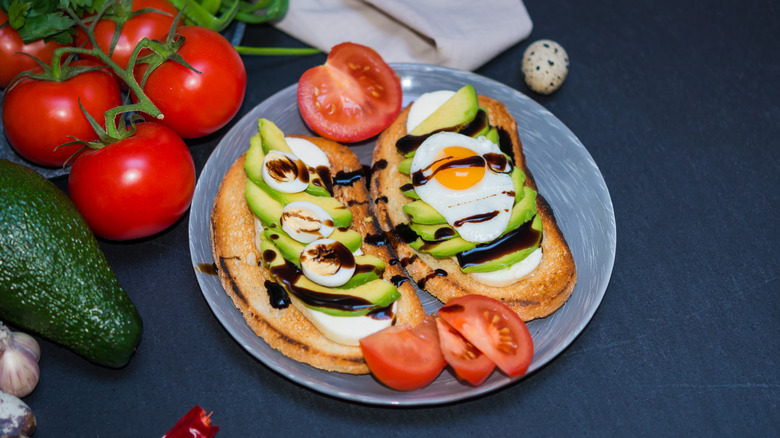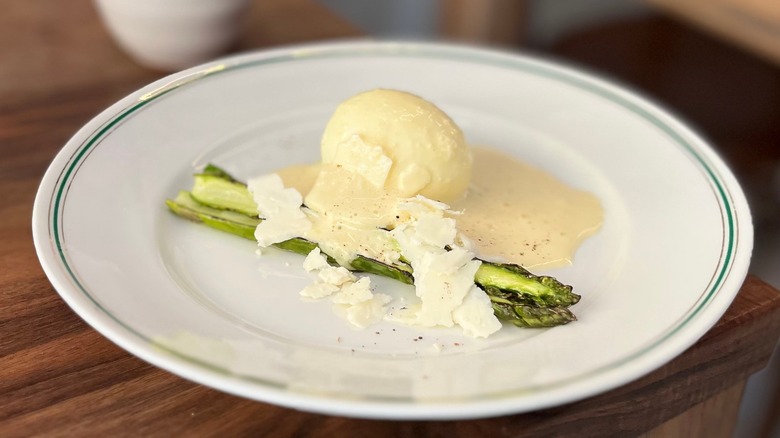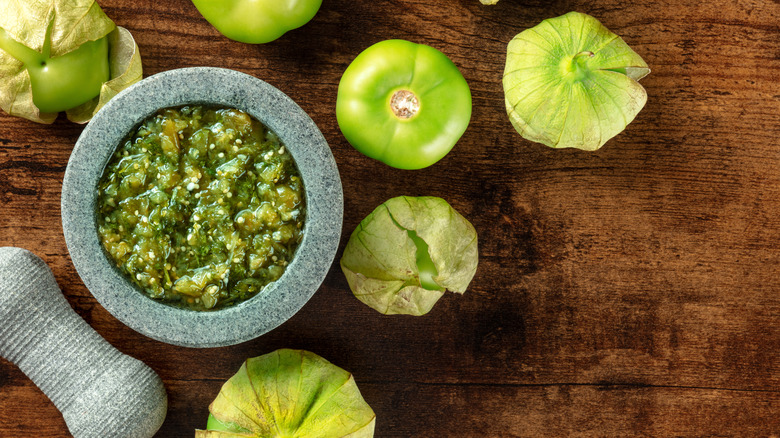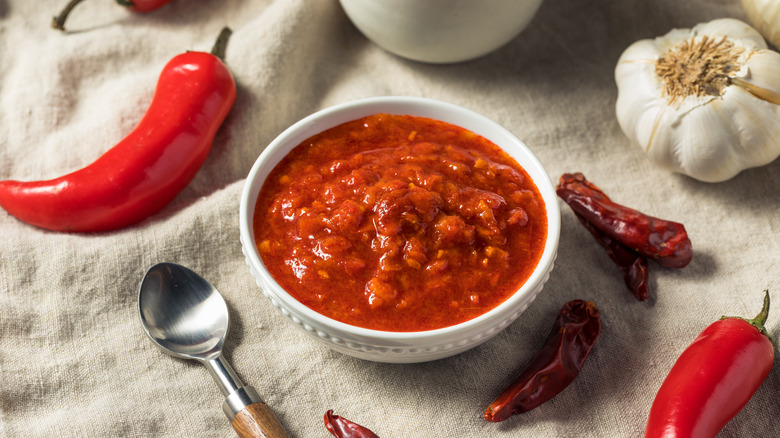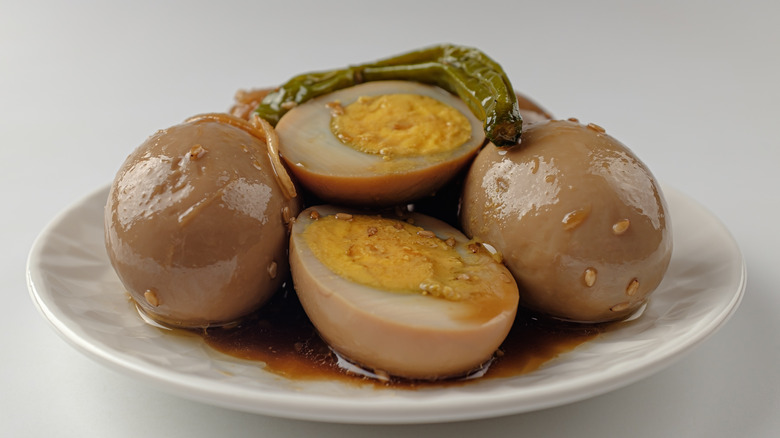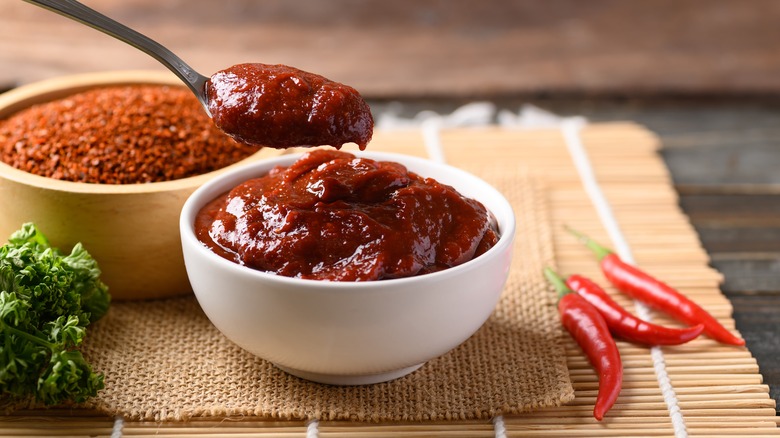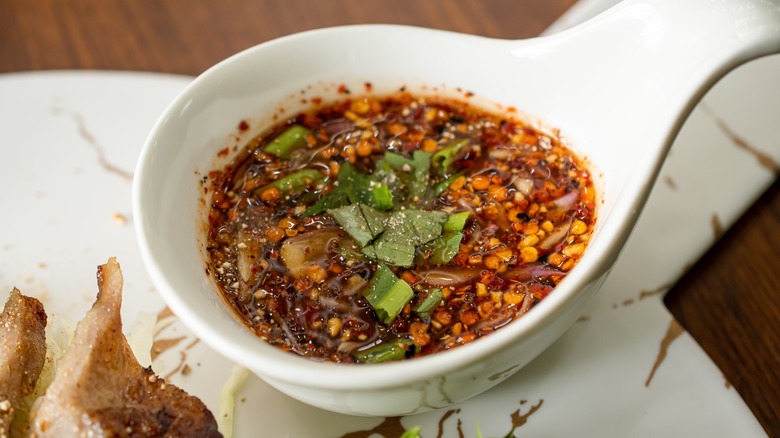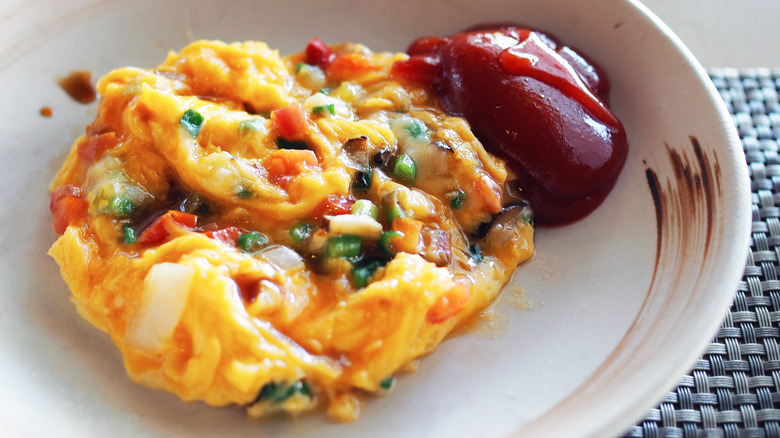The Best Sauces And Condiments For Eggs, Ranked
Ubiquitous, affordable, and nutritious, eggs are a valuable staple in most of our diets. It's a pleasant bonus that it doesn't take much skill, time, or effort to elevate their taste from mildly enjoyable to downright delicious.
The vast majority of global cuisines make use of eggs in some form or another, flavoring them with an incredible array of herbs, spices, sauces, and condiments. Exploring international foods opens up a world of culinary opportunities, from sampling traditional dishes to experimenting with a fusion of cuisines. Given their versatility, picking the right sauces and condiments for eggs is an excellent way to add some excitement and variety to your meals.
The ranked list below is somewhat subjective, based on recipes and pairings I've tried personally. However, I've factored in observations from an extensive career working in restaurants and kitchens, seeing which dishes customers love, and which ones fail to pass the taste test. Not only have I been fortunate enough to travel the world, exploring my passion for authentic international food, but a lengthy hospitality career has allowed me to sample an extensive range of menus. In an industry that demands long and unsociable hours, being able to cook quick, healthy meals for yourself is a necessity — and I've rarely found myself without a carton of eggs in my kitchen.
15. Hollandaise sauce
Known as one of French cuisine's famous "mother sauces," hollandaise is a key element in the classic brunch dish, Eggs Benedict. The sauce is surprisingly straightforward to make in your home kitchen, with a simple recipe of egg yolks, lemon juice, butter, salt, and either white or cayenne pepper.
You'll also find the creamy, buttery sauce in Eggs Benedict spin-off dishes, like Eggs Florentine which replaces the bacon with spinach, and Eggs Royale, which complements the greens with smoked salmon. Although the decadence of hollandaise sauce means you might not want to heap it onto your eggs every morning if you're watching your waistline, it's always worth treating yourself from time to time. Hollandaise is traditionally served with poached eggs, but feel free to experiment with other styles. Try using it in place of mayonnaise for richer egg sandwiches, or adding a healthy dollop to a batch of scrambled eggs.
14. Pesto
While Italian pesto is most commonly associated with pasta dishes, it pairs incredibly well with eggs. A vibrant green sauce consisting of basil, pine nuts, garlic, salt, parmesan cheese, and olive oil, it's an easy condiment to find in stores if you don't have the time to make your own.
The simplest way to complement eggs with pesto is by using it as a regular condiment, adding as much as you desire on top of fried, scrambled, or poached eggs, ideally with a couple of slices of crusty sourdough toast. However, I personally recommend cooking your eggs in the pesto itself. Sticking to a medium heat to avoid overcooking the sauce, you can use a pan to fry your eggs in the pesto, infusing them for a deeper flavor. You can also take a shakshuka-style approach, oven-baking your eggs in the pesto before topping the dish with a liberal crumbling of tangy feta cheese.
13. Chimichurri
Chimichurri is a fresh, spicy, and savory sauce native to Uruguay and Argentina, but it's not one you'll often find at the breakfast table. Traditionally, chimichurri is served as an accompaniment to grilled meats, fish, and vegetables, but its bold flavors mean it also pairs perfectly with eggs.
There are two main types of chimichurri — green and red. The green sauce is made with chopped parsley, garlic, oregano, olive oil, and red wine vinegar, while the spicier red variety is supplemented with chili and pepper flakes, and smoked paprika. Both versions add an incredibly fresh yet sharp edge to egg dishes, so it's worth trying both to find your favorite. Like pesto, you can use chimichurri sauce as a regular condiment on your preferred style of eggs. You can also create another twist on shakshuka by baking your eggs with a chimichurri-enhanced tomato or tomatillo sauce and sprinkling it with bold Cotija, a salty, aged cow's milk cheese popular in Mexico.
12. Balsamic glaze
There are countless dishes and sauces that benefit from a few splashes of balsamic vinegar, with its intense grape juice acidity adding a unique dimension to fresh and cooked foods alike. The best quality traditional balsamic vinegar comes from Italy's Reggio Emilia region where it's considered a protected and regulated product, but even the real deal can be too tart as an accompaniment for eggs.
Balsamic glaze, on the other hand, is a fantastic addition to most egg dishes. A reduction of balsamic vinegar with added sugar, balsamic glaze amplifies the sweeter flavors of the vinegar, balancing its sour qualities. A more viscous, stickier sauce. Balsamic glaze still has an extremely bold taste profile, so less is often more when adding it to your eggs. However, a light drizzle is guaranteed to give you a tastier breakfast, and it's worth experimenting with using the glaze in all your favorite egg-based meals.
11. Dukkah
Originating from Egypt and the Middle East, dukkah — or duqqa — is a deliciously aromatic spice blend of toasted seeds and nuts. While precise recipes tend to vary from region to region and family to family, the mix generally contains a combination of sesame, coriander, and fennel seeds, with ground cumin, salt, black pepper, and hazelnuts.
There are plenty of tasty ways to improve your eggs with dukkah, with one of the most popular dishes being crusted dukkah eggs — hard-boiled eggs with a jammy yolk that are peeled and rolled in the spice mix and frequently served with a natural yogurt dipping sauce. However, dukkah will also elevate a classic shakshuka, as either a sauce ingredient or final seasoning. One of the best brunches I've ever tasted was a twist on poached eggs and avocado on toast, with a liberal helping of dukkah, creamy ricotta, crunchy pomegranate seeds, and poached peach slices.
10. Brown sauce
As a Brit, subjectively, it was hard not to place brown sauce a lot higher in these rankings, but it's still considered an acquired taste by many who try it for the first time. Often referred to as HP sauce after its most popular brand, the unique condiment is a kitchen cupboard staple across most of the U.K. and Ireland.
The precise ingredients of brown sauce can vary, but it's typically made from a base of tomatoes and vinegar, with its sweet and fruity characteristics provided by sugar, molasses, dates, and apples. Some recipes include garlic, onion, and ginger alongside seasonings like allspice and fennel, but the most important ingredient is arguably sour-sweet tamarind fruit extract. There aren't many cooked breakfast foods that don't benefit from a liberal dollop of zippy brown sauce, as it pairs or contrasts perfectly with most items, and boosts the flavor of all styles of eggs.
9. Béarnaise sauce
Although béarnaise isn't considered to be one of haute cuisine's five mother sauces, it's often viewed as a sort of offspring of hollandaise sauce. The base of béarnaise sauce is essentially the same as hollandaise — starting as an emulsion of egg yolks, lemon juice, butter, and seasoning.
However, béarnaise sometimes replaces the lemon juice with a reduction of white wine vinegar. Additionally, instead of flavoring the sauce with white or cayenne pepper, béarnaise includes bolder tasting ingredients, such as shallots, tarragon, French parsley, and black peppercorns. Béarnaise is usually used as an accompaniment to steak, but can easily be used as a tangier and more herbaceous alternative to its milder parent sauce, hollandaise, and can be substituted in Eggs Benedict and its many variants to add a greater depth of flavor. Finally, if you're looking to upgrade deviled eggs with a little more elegance, béarnaise thickened with a touch of mayonnaise is a superb replacement for the traditional mustard-based filling.
8. Tomatillo salsa verde
Although tomato salsa is an excellent sauce for pairing with eggs, it's been knocked out of these particular rankings by its close cousin, salsa verde. Despite its name, salsa verde isn't just a "green salsa," and differs from classic salsa more than you might think.
This particular Mexican sauce is made with tomatillos rather than tomatoes, and while the literal Spanish translation of tomatillo is "little tomato," it's actually from a different plant entirely. The two are related, but not closely enough that you can substitute one for another. Beneath tomatillos' papery outer shells is a much tarter fruit that's mor acidic and vegetal in flavor. Salsa verde isn't a particularly complex sauce, consisting of peeled tomatillos, onion, lime juice, cilantro, and chili peppers — usually jalapeños. Whether you bake your eggs in the bright, piquant salsa or drizzle it over a Mexican-style breakfast of fried eggs and refried beans, you won't be disappointed by this alternative to classic red tomato salsa.
7. Harissa
Hailing from the Arab Maghreb region that covers central and western North Africa, harissa is an incredibly fragrant and versatile chili pepper paste that succeeds in combining familiar flavors into a truly unique condiment. Harissa paste is usually made with roasted red peppers and Baklouti peppers, a semi-sweet, mild variety.
Harissa paste also includes ingredients like garlic paste, cumin, coriander and caraway seeds, and some versions use rose water and petals to add a floral dimension to the final sauce. It's a fantastic addition to baked egg dishes, and to add more of a North African spin on your meal, you should throw in some savory chickpeas, fresh spinach, and a pinch of earthy sumac spice. If you end up using a paste that's a little too spicy, you can easily balance out the heat with a side of Greek yogurt or sour cream.
6. Soy sauce
If you've ever tried ramen eggs — hard-boiled with a jammy yolk and marinated in a delicious Asian sauce — then you've already experienced the powerful potential of soy sauce. Made from fermented soybean paste, soy sauce is famed for its ability to add umami and saltiness to almost any dish.
Delectable ramen eggs are fairly simple to make if you're careful with the marinating time, but you don't have to go that far to improve your eggs with soy sauce. If you're making scrambled eggs or an omelet, splash some soy sauce into your mixture instead of seasoning it with salt to boost the savory characteristics. A few dashes are all that's needed to enhance the flavor of the most basic egg dishes, especially rice-based recipes. Not only is soy sauce cheap and readily available but there are plenty of styles to choose from, including gluten-free and low-sodium.
5. Gochujang mayo
Gochujang is a versatile red chili paste that's considered a staple ingredient in Korean cooking. The spicy paste is typically made from fermented soybeans, glutinous rice, barley malt powder, chili powder, and salt.
Gochujang is deliciously savory, salty, sweet, and smoky, but it's sold in a highly concentrated form, so you need to be careful how you use it. You can dilute the paste with soy sauce, vinegar, and brown sugar to create a tangy hot sauce for your eggs, add a small amount to an omelet mix, or stir some into a shakshuka sauce. However, one of the quickest ways to make the most out of gochujang is to mix the paste with a high-quality mayonnaise and a squeeze of lime juice. Now you've got a punchy sauce to pair with your favorite style of eggs, and with just two ingredients, you can easily play with the ratios until they meet your tastes.
4. Nam Jim
In Thai, nam jim translates quite literally to "dipping sauce," so it's a term that covers a wide range of condiments, most of which combine sweet, sour, salty, and spicy elements. While certain ingredients are added depending on the intended food pairing, most nam jim have a base of fish sauce, lime juice, garlic, cilantro, palm sugar, and bird's eye chilies.
In Thailand, this simple form of nam jim is usually served with seafood, but it's also a great condiment for elevating grilled meats and vegetables without overpowering the flavors of the base ingredients. Nam jim can be an excellent dressing for an Asian-inspired egg salad, or simply as a fresh and fiery substitute for your regular hot sauce. If you're feeling inspired, there are countless recipes for different styles of nam jim, and you can experiment with ingredients to adjust the overall heat and flavor profile.
3 Sriracha
Purportedly invented in Thailand, sriracha is often considered a variety of nam jim, but the Thai version tends to be thinner and tangier than its U.S.-based variety. Nowadays, the most recognizable form of sriracha in the United States is the jalapeño-based condiment produced by Huy Fong Foods in California, based on the recipe of a Vietnamese immigrant.
Over the years, sriracha has become a staple hot sauce consisting of red chilies, garlic, salt, sugar, and vinegar, and there are countless dishes that benefit from the flavorsome sauce's mild spice. Like gochujang, a homemade sriracha mayo is a creamy sauce you can add to most styles of eggs, but it's not as concentrated as the hot Korean paste so can just as easily be drizzled over simple fried eggs, omelets, or scrambled eggs. In recent years, pepper shortages have impacted the availability of Huy Fong's classic hot sauce, so if you're struggling to get your hands on a bottle, it might be time to have a go at whipping up your own version at home.
2. Tomato ketchup
While tomato ketchup might not be the most unique or inventive condiment for eggs, it's hard to deny its well-earned popularity. Added vinegar and sugar give the natural tomato flavors a sweet and sour profile that undoubtedly pairs well with any style of eggs, and the mild taste is rarely overwhelming.
Admittedly, ketchups can vary quite a bit — some are sweeter than others, and some can be spicier or more acidic — so it's not uncommon to try a new brand that doesn't hit the same spot as your go-to variety. If you find tomato ketchup too sweet, a quality tomato sauce with subtle herbs and spices will also make your eggs taste great. Plus, it's an excellent base for making baked egg dishes, like shakshuka. If you're feeling particularly inventive, you can even try your hand at homemade ketchup.
1. Salt and pepper
No matter how you prefer your eggs, there's no better seasoning to start with than salt and pepper. They form a crucial element of almost every egg recipe, but they're equally as effective for the most simple preparations.
Sticking to salt and pepper is the best way to enjoy the natural flavors of eggs. The salt elevates the savory aspects of the egg white and pairs perfectly with the buttery yolk, and coarser varieties improve the texture with a subtle yet satisfying crunch. A dash of pepper introduces a touch of heat and spice and improves eggs' inherently mild taste. No matter how experimental you feel like being with your eggs, salt and pepper are the first condiments you should use. They're also ideal additions when you're short on time and need to whip up a delicious, nutritious meal without much fuss, and there are enough varieties of salt and pepper available that you can still tweak the taste of your eggs to your personal preference.



